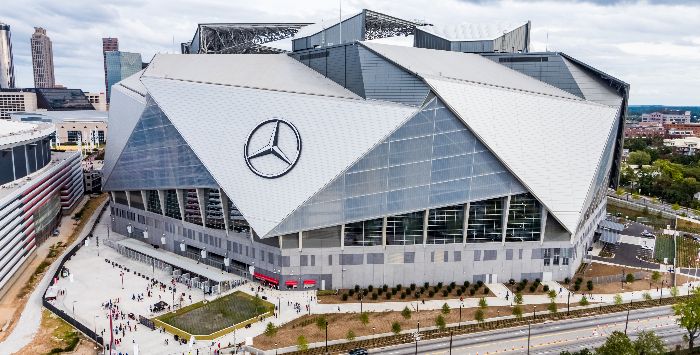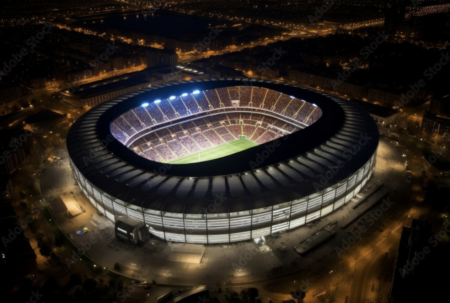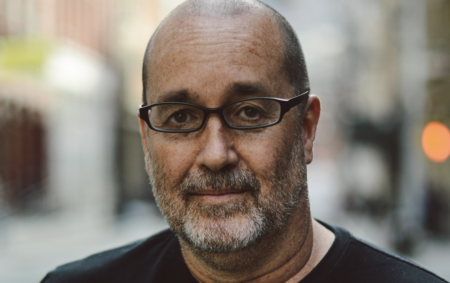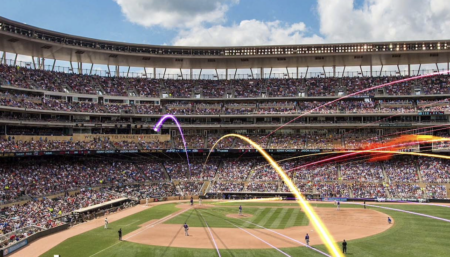I f much of the last half-century of American football stadium design can be broken down into distinct eras – be it domed stadia in the 1970s and 1980s, retractable roof stadia in the 1990s and 2000s, or the currently emerging wave of transparent-roof venues – Atlanta’s new Mercedes-Benz Stadium might be considered a more unique outlier. It’s not so much that the design by HOK represents a new era, but rather a reinvention of past and present.
“The objective from the beginning has been to break the mold and do something different in stadium design,” explains HOK principal Bill Johnson. “We felt that the industry had plateaued, especially with regard to stadia with operable roofs. I think there was an innovation curve, and then it all just sort of leveled out and started to look the same.”
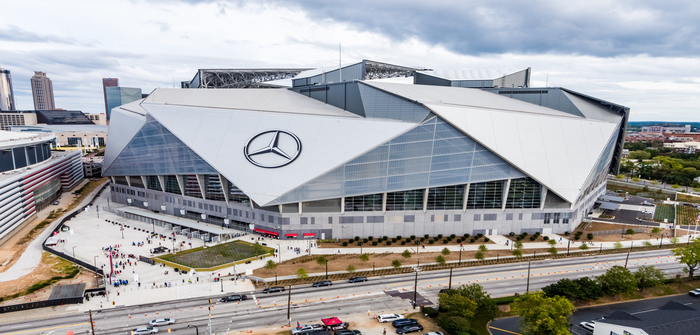
The home of the NFL’s Atlanta Falcons – as well as the MLS’s Atlanta United and a succession of concerts – Mercedes-Benz Stadium’s ambition also reflects changing industry needs. Eye-catching architectural experience is more necessary than ever to attract fans. “The buildings are being asked to really be a spectacle,” says Johnson.
“Fans now have a tendency to want to stay at home. They have so much opportunity for content off their mobile devices and the broadcasts are so good, that there’s a disincentive to come out to the game. The buildings are being asked to have a degree of showmanship that’s becoming part of the expectations.”
Center of attention
Opened in September 2017 and with a budget of more than US$1.5bn, Mercedes-Benz Stadium is the first facility with a retractable roof that opens not with a single side-to-side mechanism, but with eight pieces moving outward from the center, resembling the petals of a flower. Designed by HOK in collaboration with TVS Design and engineer BuroHappold, with Birdair as a specialty contractor for the roof and façade’s ETFE, the roof can open in 10-12 minutes, much faster than comparable stadia.
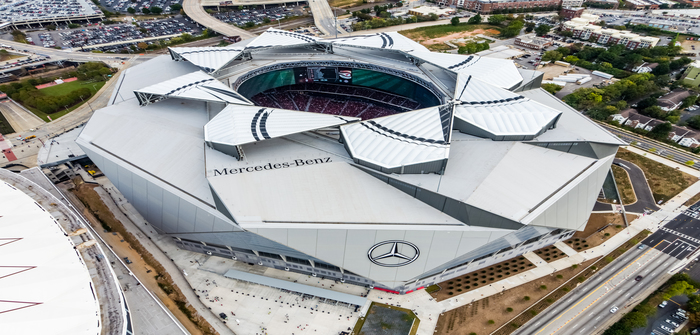
“Our beginning idea was when the roof opened, it needed to be something special and unexpected,” Johnson says. “We imagined this pinpoint of light that, as the roof opened, would grow and become this dramatic opening.” But the execution has also been challenging, subjecting the project to months of delays.
“With that innovation comes a learning curve every step of the way,” Johnson adds. “It was more difficult and involved than anything anybody had anticipated.”
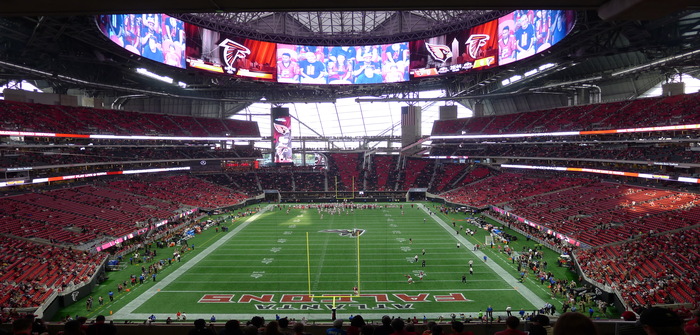
Below the circular roof opening is something just as unprecedented: a first-of-its-kind digital LED video scoreboard display curving 360° in the shape of a halo. Developed by Daktronics and featuring technical infrastructure created by IBM, the 63,800ft2 video display will be the largest at any American sports stadium. “A lot of people talk about the roof, but
as cool as it is, it’s probably not as special as the video halo,” explains Mike Gomes, senior vice president of fan experience for AMB Sports & Entertainment Group (AMBSE), team owner Arthur Blank’s company. “I think that seems to be the thing people are mesmerized by. Wherever you are in those concourses you see that digital display. It’s very anchoring. You’re always connected to what’s going on. There’s very few places in the building where you don’t have a view to the halo. In the industry, one thing we’re always confronted with is that connectivity. If you go to the concessions you don’t want to miss something. There’s a reluctance to leave your seats. I think this building will be transformational for the fans because of that connection. It’s not about sitting in a row. It’s wanting to move around and see the event from different perspectives.”
View to a thrill
The building is noticeably transparent, with more glass and transparent ETFE than even facilities such as Minneapolis’s US Bank Stadium, which has ETFE covering half its roof. Mercedes-Benz Stadium’s angular metal façade on the upper portion of the stadium gives way to whole walls of glass below – manufactured and installed by Crown Corr – which not only can be partially opened to allow natural ventilation, but also gives attendees a view out to the city.
“We needed a building that when open could feel open,” explains Falcons team president Rich McKay. “We wanted transparency. We wanted it to be an invitation to come to this building, and a window to the city. The money shot on TV will be this huge opening in the east side of the building facing downtown.”
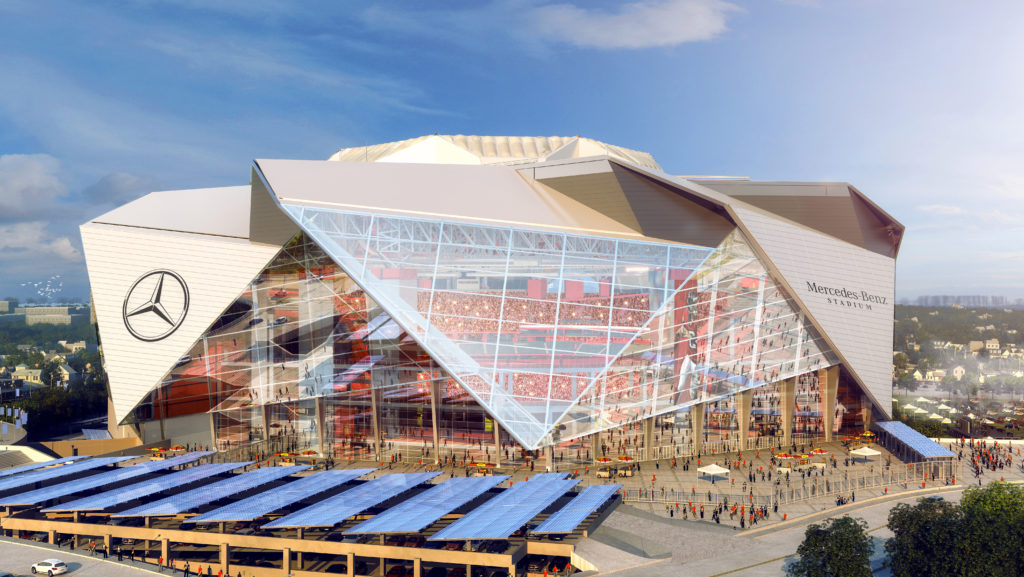
With so much transparency, the designers were challenged to balance the desire for light and openness with the extra heat gain that can result. For example, the petals of the roof opening were initially intended to be clear, but mechanical studies showed that “it was impossible to keep the building cool”, Johnson explains.
“It’s always a balancing act in terms of how clear and open the building can be.” The real challenge, though, was the south and west façades of the building, where the ETFE caused what the architect calls an “extreme” heat gain. Instead of minimizing the material, though, the architects created a frit that goes over it. “On the east side with the view of the skyline and on the north side it’s 100% clear. Elsewhere, the dot screen becomes more and more opaque,” Johnson says. “On the west, it becomes up to 70% fritted.”
Food for thought
While the roof, video halo display and the views outside will attract the most initial attention, AMB Group and the Falcons paid equal attention to improving the fan experience, holding a series of focus groups and fan councils to learn what ticket-buyers valued most. “For so long stadia were about increasing revenue, but in doing that, they’ve often missed how the true fan and their experience is impacted,” McKay says. Yet if a great fan experience can be created, he adds, the revenue will take care of itself.
The inflated costs of concession F&B and retail are often the biggest target of fan ire, so Mercedes-Benz Stadium targeted lower prices. “Fans have been gouged for years. We all know it. Every ballpark, every arena, we overpay for food and beverage,” Gomes says. “You want to have a couple beers and an ice cream for the kid. Why does that have to be so expensive? We aggressively hit that head on. Our pricing tries to have fans pay what they would at a local restaurant.”
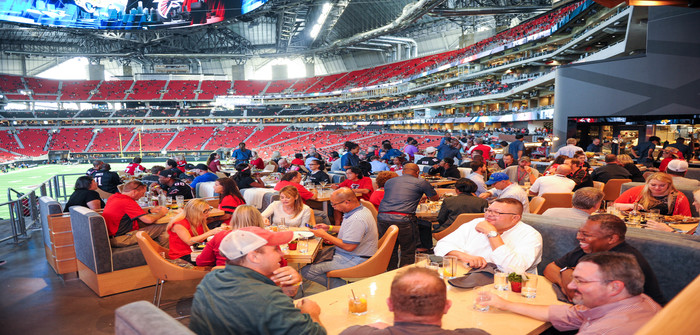
To make sure a high enough volume of fans patronize concessions to make the lower prices still profitable, the owners also sought to improve quality and consistency of concessions.
“We’ve added so much more cooking capacity in the building. It’s not coming from a central commissary,” Gomes says. The stadium also has 65% more points of sale than the Georgia Dome. “From a concession standpoint, it’s not easy to say, ‘Let’s lower prices’. You have to approach it assuming you’ll have a pricing model that changes demand.”
All told, Mercedes-Benz Stadium is has become not just a sold-out venue for sports events and concerts, but a true landmark. “Great cities have great structures people remember,” Johnson says. “This will be that building for Atlanta. This was not an easy project to pull off. But there’s a reason there’s already over a billion dollars in sponsorship for this building. Great design means something to people.”


